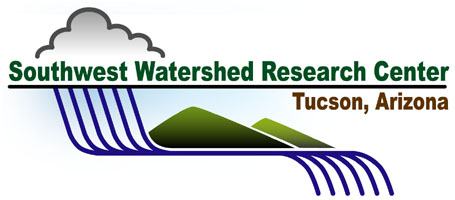| SWRC Bulletin (Winter 2006) |

|
  |  | The SWRC BulletinSound Science for Water Decisions Winter 2006 |
Upcoming Special Section of the AGU journal Water Resources Research dedicated to "Fifty Years of Research and Data Collection, U.S.D.A. Walnut Gulch Experimental Watershed". Click here for full list of WRR submissions or look at abstracts in "latest science results" below. Latest Science Results (not yet published) (click on title for more information) | Highlight from Recently Published Research An important element to assess the influence woody plant encroachment in rangelands is to determine how the ratio of transpiration to evapotranspiration is altered. Shown above is the partitioning of daily evapotranspiration (total bar height) into evaporation and shrub transpiration, and total daily precipitation for the 2004 growing season at the Lucky Hills Study Area, WGEW. Before the monsoon season began, both E and T were essentially zero. At the onset of the monsoon rains, E dominated ET as it took approximately ten days for the plants to recover from their down-regulated, dormant state and respond to the precipitation. Later, during interstorm periods, T was dominant and E was small. For the remainder of the growing season, E was high only on, and shortly after, days with rainfall. From Figure 3, Scott, R.L., Huxman, T.E., Cable, W.L., and Emmerich, W.E. 2006. here AND in "recently published research" list Papers Published This Quarter: (click on title to download a reprint) Farid A., Goodrich, D.C., Sorooshian S. 2006. Using airborne lidar to discern age classes of cottonwood trees.Western J. of Applied Forestry, 21(3):149-158. Scott, R.L., Huxman, T.E., Cable, W.L., Emmerich, W.E. 2006. Partitioning of evapotranspiration and its relation to carbon dioxide exchange in a Chihuahuan desert shrubland.Hydrological Processes. Special Issue on Emerging Issues of Ecohydrology in Semiarid Areas, eds. Wilcox , B. and Scanlon, B., 20: 3227-3243. Marsett, R.C., Qi, J., Heilman, P., Biedenbender, S.H., Watson, C., Amer, S., Weltz, M.A., Goodrich, D.C., Marsett, R. 2006. Remote sensing for grassland management. In the Arid Southwest.Rangeland Ecology and Management 59(5): 530-540. Williams, D.G, Scott, R.L., Huxman, T.E., Goodrich, D.C, Lin,g. 2006. Sensitivity of riparian ecosystems to moisture pulses in semiarid environments.Hydrological Processes. Special Issue on Emerging Issues in Rangeland Ecohydrology, eds. Wilcox , B. and Thurlow, T., 20: 3191-3205. Cate, A., Goodrich, D.C., Guertin, D.P. 2006. Integrating hydrologic models and spatial data in a distributed internet application.Proc. 3rd Fed. Interagency Hydrologic Modeling Conf., April 2-6, 2006. Reno, Nevada. 2006 CDROM. Semmens, D.J., Miller, S.N., Goodrich, D.C. 2006. Towards an automated tool for channel-network characterization, modeling, and assessment.Proc. 3rd Fed. Interagency Hydrologic Modeling Conf., April 2-6, 2006. Reno, Nevada. 2006 CDROM. Goodrich, D.C., Unkrich, C.L., Smith, R., Woolhiser, D. 2006. KINEROS2 - New features and capabilities.Proc. 3rd Fed. Interagency Hydrologic Modeling Conf., April 2-6, 2006. Reno, Nevada. 2006 CDROM. Goodrich, D.C., Scott, S., Hernandez, M., Burns, I.S., Levick, L.R., Cate, A., Kepner, W., Semmens, D.J., Miller, S.N., Guertin, D.P. 2006. Automated geospatial watershed assessment (AGWA) - A GIS-based hydrologic modeling tool for watershed management and landscape assessment.Proc. 3rd Fed. Interagency Hydrologic Modeling Conf., April 2-6, 2006. Reno, Nevada. 2006 CDROM. Levick, L..R., Guertin, D.P., Scott, S., Semmens, D.J., Goodrich, D.C. 2006. Automated geospatial watershed assessment tool (AGWA) - Uncertainty analysis of common input data.Proc. 3rd Fed. Interagency Hydrologic Modeling Conf., April 2-6, 2006. Reno, Nevada. 2006 CDROM. Our full publication list is available at Future Science Events:
Rainfall Report:
WGEW and SRER data can be downloaded from the web site at http://www.tucson.ars.ag.gov/dap
Geographic locations of the three precipitation records can be found at /ARSUserFiles/20221000/images/sw_az3.jpg Awards: The SWRC staff received more awards for hard work and research. Click here for details. Staff News: SWRC Bulletin: Contact the SWRC Research Leader, Dr. Mark Nearing at 670-6380 x152 or mnearing@tucson.ars.ag.gov. Mailing address is USDA ARS SWRC, SWRC To develop knowledge and technology to conserve water and soil in semi-arid lands. |





